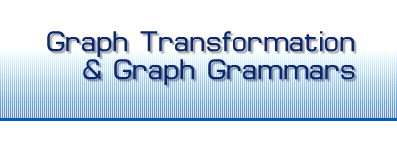Graphical
structures of various kinds (like graphs, diagrams,
visual sentences and others) are very useful to
describe complex structures and systems in a direct
and intuitive way. These structures are often
augmented by formalisms which add to the static
description a further dimension modelling the
evolution of systems via any kind of transformation
of such graphical structures. The field of Graph
Transformation is concerned with the theory,
applications and implementation issues of all these
formalisms.
The theory is strongly related to areas such as
graph theory and graph algorithms, formal language
and parsing theory, theory of concurrency and
distributed systems, formal specification and
verification, logic and semantics. The application
areas include all those fields of Computer Science,
Information Processing, Engineering and Natural
Sciences where static and dynamic modeling
by graphical structures and graph transformations,
respectively, play an important role. In many of
these areas tools based on graph transformation
technology have been implemented and used.
Topics of interest include, but are not limited
to, the following.
On the more theoretical side:
- General models of graph transformation
- Node-, edge-, and hyperedge replacement graph
grammars
- Parallelism, concurrency, distribution
- Term graph rewriting
- Network computing
- High-level and adhesive replacement systems
- Hierarchical graphs and decompositions of
graphs
- Logic expression of graph transformation
properties
- Graph theoretical properties of graph
languages
- Geometrical and topological aspects of graph
transformation
- Automata on graphs and parsing of graph
languages
- Analysis and verification of graph
transformation systems
- Structuring and modularisation concepts
- Semantics of graph transformation-based
languages
- Semantics of UML and other visual modelling
techniques
On the more applied side:
- Implementation of programming languages
- Massively parallel computing
- Bioinformatics and system biology
- Bio-computing and DNA-computing
- Software architecture
- Mobile systems design
- Model transformation
- Model based software development
- Development of meta CASE tools
- Visual languages and environments
- Graph tool development
- Graph based models of computations
- Petri nets
- Rule- and knowledge-based systems
- Pattern generation and picture processing
- Layout algorithms
- Software quality and testing
- Security
- Graph and graph transformation exchange
|



